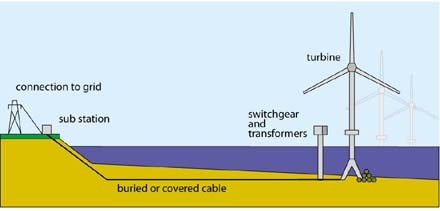Dec 10 2007
Harnessing the vast potential of the UK's island status entered a new phase as Energy Secretary John Hutton announced proposals to open up its seas to up to 33GW (gigawatts) of offshore wind energy. He also announced that he will chair a panel of experts to advise him on renewable energy, underscoring the UK Government's determination to play its part in meeting the EU target of 20% renewable energy by 2020.
 A typical wind farm
A typical wind farm
Speaking to the European energy industry in Berlin, Mr Hutton launched a Strategic Environmental Assessment of the seas surrounding the UK, paving the way for a possible 'third round' of wind energy development and beyond:
"The draft plan I'm setting out today could allow companies to develop up to 25 gigawatts of offshore wind by 2020, in addition to the 8 gigawatts already planned.
"This potential major expansion will be subject to the outcome of a Strategic Environmental Assessment. But if we could manage to achieve this, by 2020 enough electricity could be generated off our shores to power the equivalent of all of the UK's homes. This could be a major contribution towards meeting the EU's target of 20% of energy from renewable sources by 2020.
"The challenge for Government and for industry is to turn this potential - for our energy and economy - into a cost-effective reality. This will be a major challenge.
"The UK has some of the best offshore wind resource in the world, a long history of design, installation and operational expertise in the offshore environment and the skills and manufacturing capability to transfer to this exciting new sector.
"The UK is now the number one location for investment in offshore wind in the world and next year we will overtake Denmark as the country with the most offshore wind capacity. I want to ensure the UK remains one of the best places for renewable business.
"Our trajectory on renewables is beyond question. They are as central to our future low carbon economy as chimneys were to the industrial revolution and road building following the invention of the mass produced car."
The 'first round' of offshore wind farms, in 2001, comprised a number of small demonstration projects. The 'second round', in 2003, resulted in the award of options for leases for larger scale projects in three designated areas - the Thames Estuary, the Greater Wash and the North West. Based on current plans under the first and second leasing rounds, about 8GW of capacity could be operational by around 2014. This includes the 1GW London Array which is the largest planned offshore wind farm in the world.
The proposal for a possible 'third round', and further regular rounds, of offshore wind development announced today would open up the vast bulk of the UK's continental shelf to large scale development. It would allow for up to a further 25GW of offshore capacity on top of the planned 8GW. In total this could generate enough power for up to 25 million homes by 2020.
Mr Hutton announced that he will chair an enhanced Renewable Advisory Board with a bigger remit to advise the Government on the EU 2020 renewable energy target, and a wider pool of expertise to help deal with the issues and opportunities across renewable energy.
The Government is also working on a regulatory regime to ensure that all offshore projects can connect to our onshore electricity transmission and distribution networks, quickly, securely and as cheaply as possible. A response to the recent consultation will be published by BERR shortly.
These developments sit alongside plans in the Energy Bill, to be introduced shortly, to 'band' the support provided by the Renewables Obligation to give greater support to offshore wind, wave and tidal energy. This will incentivise the expansion envisaged by today's proposals.
The amount of electricity from renewable sources of all kinds in the UK has doubled to almost 5% since the introduction of the Renewables Obligation in 2002. Current forecasts will see a further tripling to around 15% by 2015. Plans are also under way for a feasibility study into the potential for electricity generation from the Severn Estuary.
At the Spring European Council the EU agreed a target of 20% of all energy from renewables by 2020. This includes fuel for electricity, heat and transport. The Commission is due to propose how that target should be apportioned between Member States in January.
http://www.offshore-sea.org.uk/